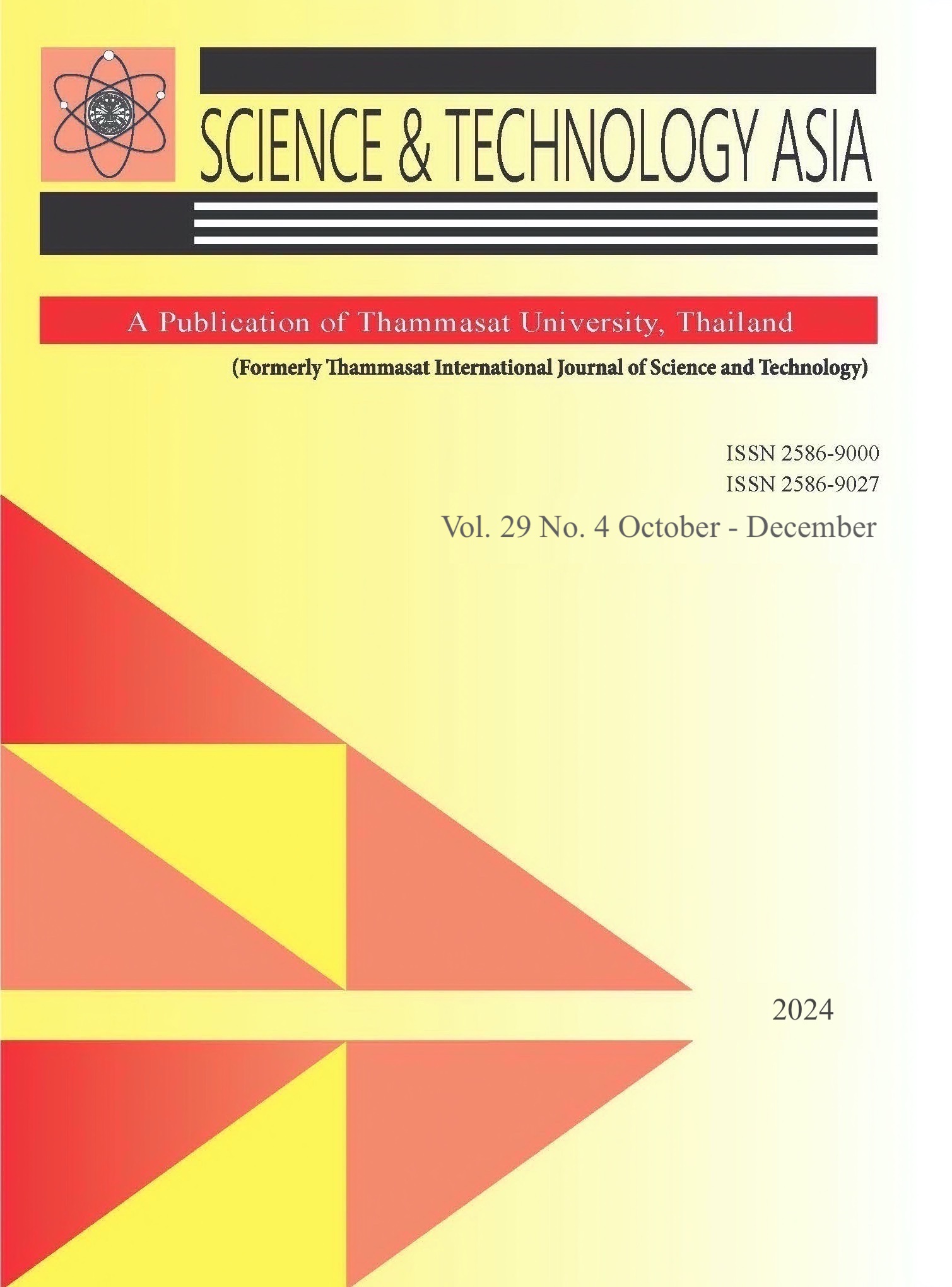Application of Scenedesmus Quadricauda Biosorbent for the Biosorption of Heavy Metals in Wastewater
Main Article Content
Abstract
Heavy metal contamination in wastewater is a critical environmental concern, affecting ecosystems, water quality, and food safety. Conventional treatment methods, including precipitation and ion exchange, are often resource-intensive and may inadequately remove heavy metals, allowing them to persist in the environment. This study investigated biosorption as a sustainable alternative, specifically evaluating the green microalga Scenedesmus quadricauda for the removal of copper and zinc ions from synthetic wastewater. Batch biosorption experiments were conducted under optimized conditions of pH 6, a contact time of 60 minutes, and a temperature of 28°C. The results revealed high removal efficiencies, with Scenedesmus quadricauda achieving 81% removal of copper and 73% of zinc. Further optimization of pH and biosorbent dosage enhanced performance, with copper removal reaching 91% at pH 6 and zinc removal at 82.85% with a biosorbent dose of 0.5 g/L. These findings demonstrate the efficiency of Scenedesmus quadricauda as an efficient biosorbent for heavy metal remediation, supporting studies on biosorption as a viable and environmentally friendly approach to wastewater treatment. This study thus highlights biosorption's potential as a long-term solution for mitigating heavy metal pollution in wastewater.
Article Details

This work is licensed under a Creative Commons Attribution-NonCommercial-NoDerivatives 4.0 International License.
References
Oliomogbe T.I., Emegha J.O., Ukhurebor K.E.Microorganism Derived Biosorbent in the Sequestration of Contaminants from the Soil, In Adsorption Applications for Environmental Sustainability. IOP Publishing, 2023. p. 10.1-10.20.
Ukhurebor K.E., Aigbe U.O., Onyanche R.B et al. Introduction to the state of the art and relevant aspects of the applications of adsorption for environmental safety and sustainability. In Adsorption Applications for Environmental Sustainability.IOP Publishing, 2023; p.1.1-1.17.
Acheampong MA,Meulepas RJ, Lens W. Removal of heavy metals and cyanide from gold mine wastewater. J. Chem. Technol. Biotechnol.2010; 5:590-613.
Xie Y, Fan J, Zhu W, Amombo E, Lou Y, Chen L, Fu J. Effect of Heavy Metals Pollution on Soil Microbial Diversity and Bermudagrass Genetic Variation. Front. Plant Sci. 2016.
Dixit R., WasiullahMalaviya D et al. Bio remediation of Heavy Metals from Soil and Aquatic Environment: An Overview of Principles and Criteria of Fundamental Processes. 2015; 2: 2189-212.
Gaur N, Flora G, Yadav M, Tiwari A.A review with recent advancements on bioremediation-based abolition of heavy metals. Environ Sci Process Impacts. 2014; 2: 180-93.
Tak HI, Ahmad F, Babalola OO.Advances in the Application of Plant Growth-Promoting Rhizobacteria in Phytoremediation of Heavy Metals.In Reviews of Environmental Contamination and Toxicology, Springer New York. 2013; 33-55.
Li K., Liu Q., Fang F., Luo R., Lu Q. et al. Microalgae-based wastewater treatment for nutrients recovery: A review. Bioresour. Technol, 2019; 121934.
David M. (2019) Factors influencing the bio removal of copper and zinc from wastewater using microalgae, bacteria, and their consortia. Master Thesis, Universidad de Valladolid.
Emegha JO, Oliomogbe TI, Okpoghono J, Babalola AV, Ejelonu CA, Elete DE.Ukhurebor KE. Green Derived Biosorbents for the Degradation of Petroleum Contaminants.In Adsorption Applications for Environmental Sustainability.IOP Publishing.2023. p. 12.1-20.
Vijayaraghavan K, Padmesh TVN, Palanivelu K, Velan M. Biosorption of nickel(II) ions onto Sargassumwightii: application of two parameter and threeparameter isotherm models. J Hazard Mater 2006; 133: 304-8.
Egboduku WO,Egboduku T, Emegha JO, Imarhiagbe O. Biosorbents Derived from Invasive Plants for Environmental Remediation. In Adsorption Applications for Environmental Sustainability, IOP Publishing, 2023. p. 9.1-9.15
Volesky B., HolanZ.R..Biosorption of heavy metals. Biotechnol.Prog 1995;3, 235-50.
Wai SC, Viggy WGT, Heli M, Vijai KG. Multifaceted roles of microalgae in the application of wastewater biotreatment: A review.Environ. Pollut.2021;269: 116236.
Rajesh K. (2014) Heavy metal biosorption using algae, BSc thesis, National Institute of Technology, National Institute of Technology, Rourkela, India.
Freire-Nordi CS, Vieira AAH., Nascimento OR. The metal binding capacity of Anabaena spiroides extracellular polysaccharide: an EPR study. Process Biochem. 2005:6, 2215-24.
Omar HH.Bioremoval of zinc ions by Scenedesmusobliquus and Scenedesmusquadricauda and its effect on growth and metabolism.Int. Biodeterior.2002; 2: 95-100.
Hassan S, Awad Y, Kabir M, Oh S, Joo J. Bacterial Biosorption of heavy metals. In Biotechnology Cracking New Pastures, MD Publications PVT LTD New Delhi, 79 – 110; 2010.
Mirghaffari N, Moeini E, Farhadian O. Biosorption of Cd and Pb ions from aqueous solutions by biomass of the green microalga, Scenedesmus quadricauda. J Appl Phycol. 2015; 27: 311-20.
Dmytryk A, Saeid A, Chojnacka K. Biosorption of microelements by Spirulina: towards technology of mineral feed supplements. TheScientificWorldJournal. 2014: 356328.
Kainth S, Sharma P, Pandey OP. Green sorbents from agricultural wastes: A review of sustainable adsorption materials. Applied Surface Science Advances. 2024;19:100562.
Gu S, Lan CQ. Effects of culture pH on cell surface properties and biosorption of Pb(II), Cd(II), Zn(II) of green alga Neochloris oleoabundans. Chem Eng J. 2023;468:143579.
Cruz-Lopes L, Macena M, Esteves B, Guiné R. Ideal pH for the adsorption of metal ions Cr6+, Ni2+, Pb2+ in aqueous solution with different adsorbent materials. Open Agric. 2021;6(1):115-23.
Torres E. Biosorption: A Review of the Latest Advances. Processes. 2020;8(12):1584.
Papadimitriou K, Alegría Á, Bron PA, de Angelis M, Gobbetti M, Kleerebezem M, et al. Stress Physiology of Lactic Acid Bacteria. Microbiol Mol Biol Rev. 2016;80(3):837-90.
Cruz-Lopes L, Macena M, Esteves B, Guiné R. Ideal pH for the adsorption of metal ions Cr6+, Ni2+, Pb2+ in aqueous solution with different adsorbent materials. Open Agric. 2021;6(1):115-23.


